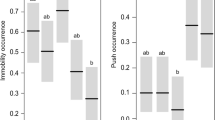Summary
In southeastern Arizona, Polyergus breviceps conducts slave raids on Formica gnava. Intraspecific territorial raids are frequent, and result in brood capture when the invaded colony is small. Target Formica colonies are located by one or more Polyergus scouts. Field tests show that scouts use optical orientation when returning from the target nest to their own colony, and when leading nestmates on the slave raid back to the Formica colony (Fig. 1). Both scouts and raiders deposit a chemical trail as they move out on the raid. After the raid, the Polyergus workers orient to their home nest by simultaneously using optical cues and the chemical trail deposited on the outbound raid.
Similar content being viewed by others
References
Alloway TM (1979) Raiding behaviour of two species of slave-making ants, Harpagoxenus americanus (Emery) and Leptothorax duloticus Wesson (Hymenoptera: Formicidae). Anim Behav 27:202–210
Alloway TM (1980) The origins of slavery in Leptothoracine ants. Am Nat 115:247–261
Alloway TM (1982) How the slave-making ant Harpagoxenus americanus affects the pupa-acceptance behavior of its slaves. In: Breed M Michener CH, Evans HE (eds) The biology of social insects. Westview Press, Boulder, Colo, pp 261–265
Buschinger A, Alloway TM (1977) Population structure and polymorphism in the slave-making ant Harpagoxenus americanus (Emery) (Hymenoptera: Formicidae). Psyche 83: 233–242
Buschinger A, Alloway TM (1978) Caste polymorphism in Harpagoxenus canadensis MR Smith (Hym, Formicidae). Insectes Soc 25:339–350
Buschinger A, Alloway TM (1979) Sexual behavior in the slave-making ant, Harpagoxenus canadensis MR Smith, and sexual pheromone experiments with H. canadensis, H. americanus (Emery), and H. sublaevis (Nylander). Z Tierpsychol 49:113–119
Czechowski W (1977) Recruitment signals and raids in slave-maker ants. Ann Zool (Warsaw) 34:1–23
Darwin C (1859) On the origin of species. Murray, London
Dobrzański J (1965) Genesis of social parasitism among ants. Acta Biol Exp (Warsaw) 25:59–71
Dobrzańska J (1978) Problem of behavioral plasticity in the slave-making amazon ant Polyergus rufescens Latr and in its slave ants Formica fusca L. and Formica cinerea Mayr. Acta Neurobiol Exp 38:113–132
Harman JR (1968) Some aspects of the ecology of the slave-making ant, Polyergus lucidus. Entomol News 79:217–223
Henquell D, Abdi H (1981) Influence réspective des répères visuels et des répères chimique dans l'orientation de Formica polyctena au cours de l'exploitation d'une source de nouriture. Insectes Soc 28:47–66
Hölldobler B (1976) Tournaments and slavery in a desert ant. Science 192:912–914
Hölldobler B (1981) Foraging and spatiotemporal territories in the honey ant Myrmecocystus mimicus Wheeler (Hymenoptera: Formicidae). Behav Ecol Sociobiol 9:301–314
Hölldobler B, Lumsden CJ (1980) Territorial strategies in ants. Science 210:732–739
Jander R (1957) Die optische Richtungsorientierung der Roten Waldameise (Formica rufa L.). Z Vergl Physiol 40:162–238
Kwait E, Topoff H (1983) Emigration raids by slave-making ants: a rapid-transit system for colony relocation. Psyche 90:307–312
Marlin JC (1969) The raiding behavior of Polyergus lucidus in central Illinois (Hymenoptera: Formicidae). J Kans Entomol Soc 42:108–115
Marlin JC (1971) The mating, nesting, and ant enemies of Polyergus lucidus Mayr. Am Midl Nat 86:181–189
Regnier FE, Wilson EO (1971) chemical communication and “propaganda” in slave-making ants. Science 172:267–269
Stuart RJ, Alloway TM (1982) Territoriality and the origin of slave raiding in leptothoracine ants. Science 215:1262–1263
Talbot M (1967) Slave raids of the ant Polyergus lucidus. Psyche 74:299–313
Talbot M (1968) Flights of the ant Polyergus lucidus Mayr. Psyche 75:46–52
Topoff H, Lawson K (1979) Orientation of the army ant Neivamyrmex nigrescens: integration of chemical and tactile information. Anim Behav 27:429–433
Wehner R, Duelli P (1971) The spatial orientation of desert ants, Cataglyphis bicolor, before sunrise and after sunset. Experientia 27:1364–1366
Wehner R, Menzel R (1969) Homing in the ant Cataglyphis bicolor. Science 164:192–194
Wheeler WM (1916) Notes on some slave raids of the western amazon ant (Polyergus breviceps). J NY Entomol Soc 24:107–118
Wilson EO (1971) The Insect Societies. Belknap Press of Harvard University Press, Cambridge, Mass
Wilson EO (1975) Leptothorax duloticus and the beginnings of slavery in ants. Evolution 29:108–119
Author information
Authors and Affiliations
Rights and permissions
About this article
Cite this article
Topoff, H., LaMon, B., Goodloe, L. et al. Social and orientation behavior of Polyergus breviceps during slave-making raids. Behav Ecol Sociobiol 15, 273–279 (1984). https://doi.org/10.1007/BF00292989
Received:
Accepted:
Issue Date:
DOI: https://doi.org/10.1007/BF00292989




